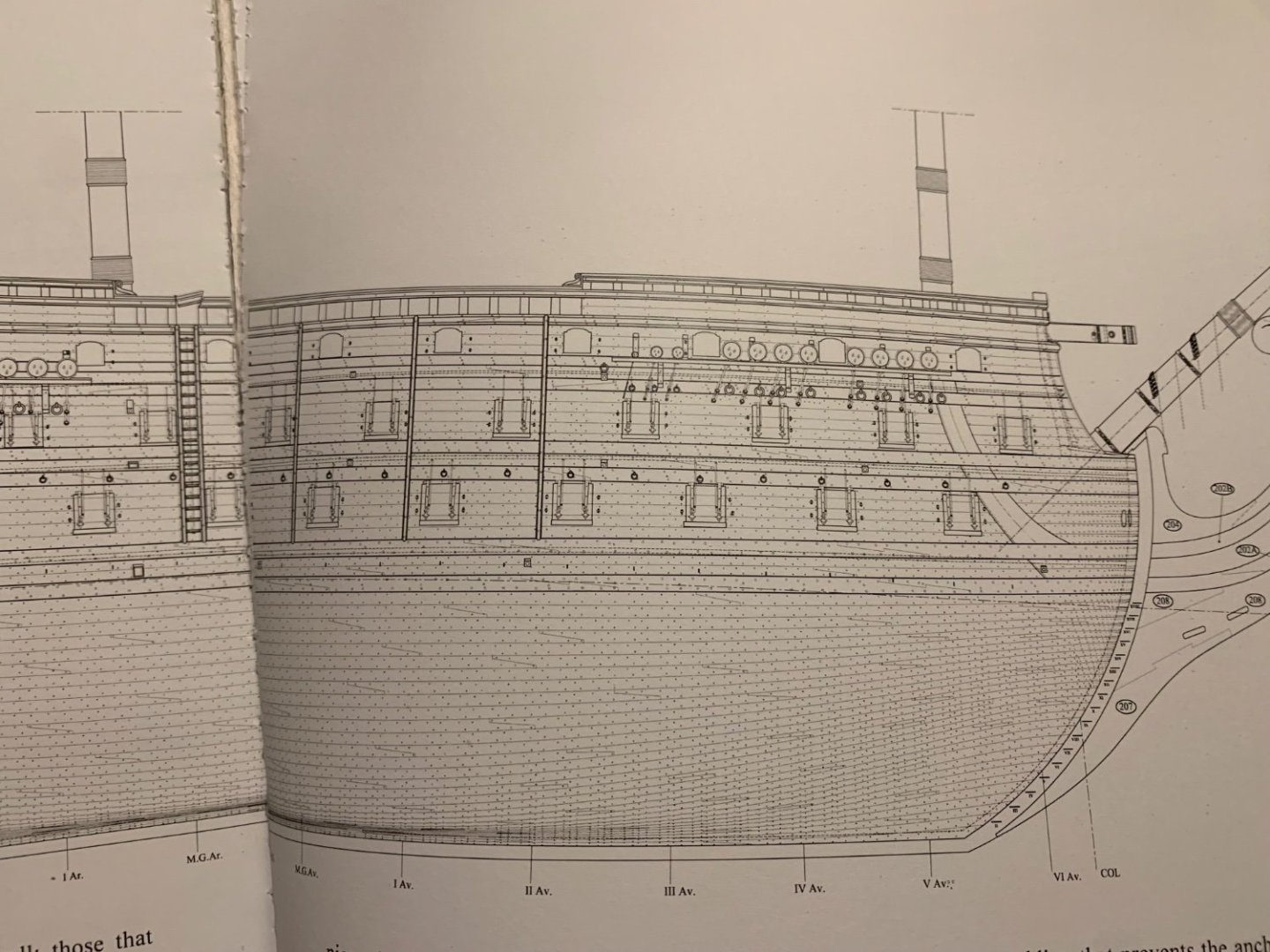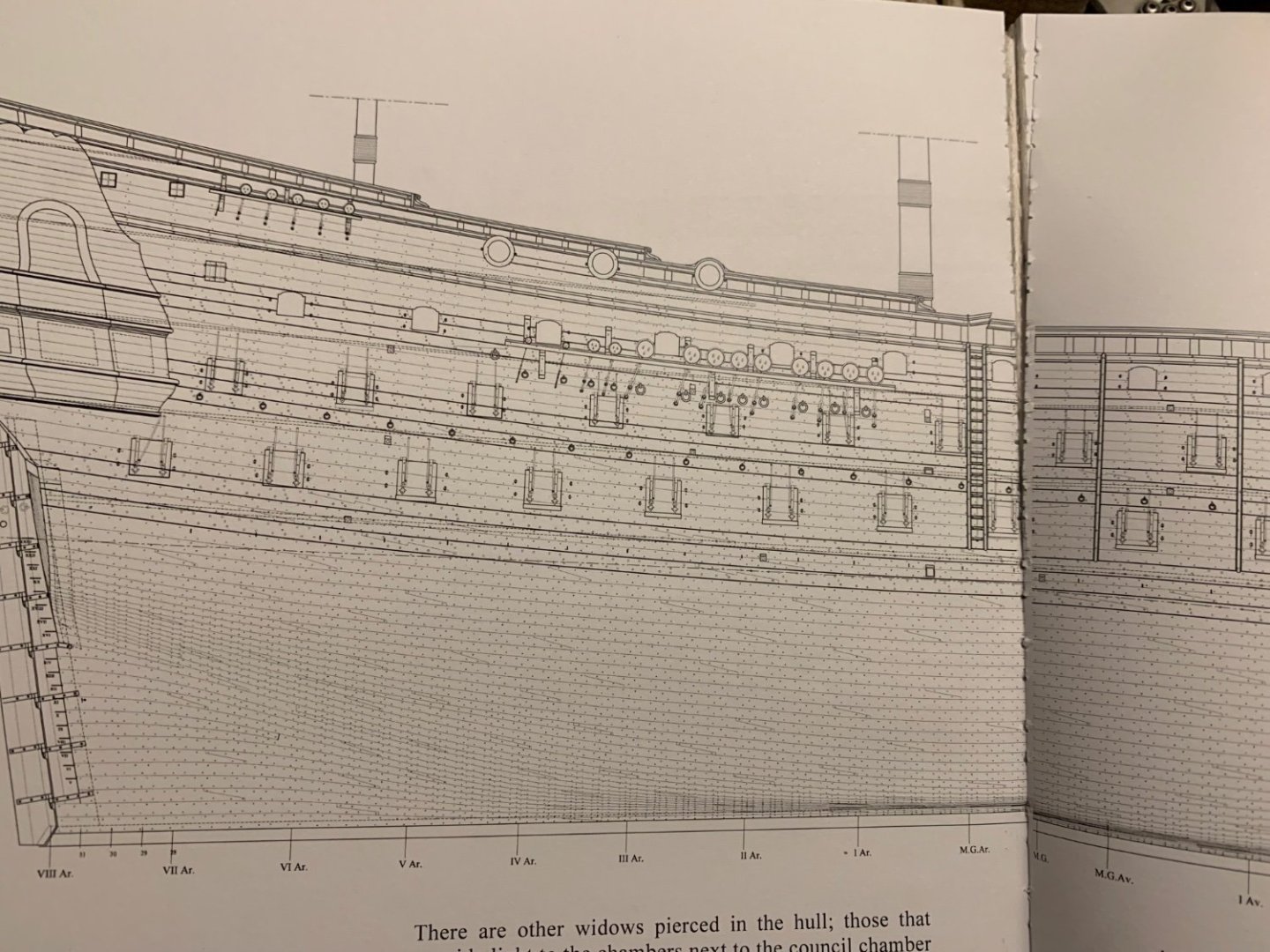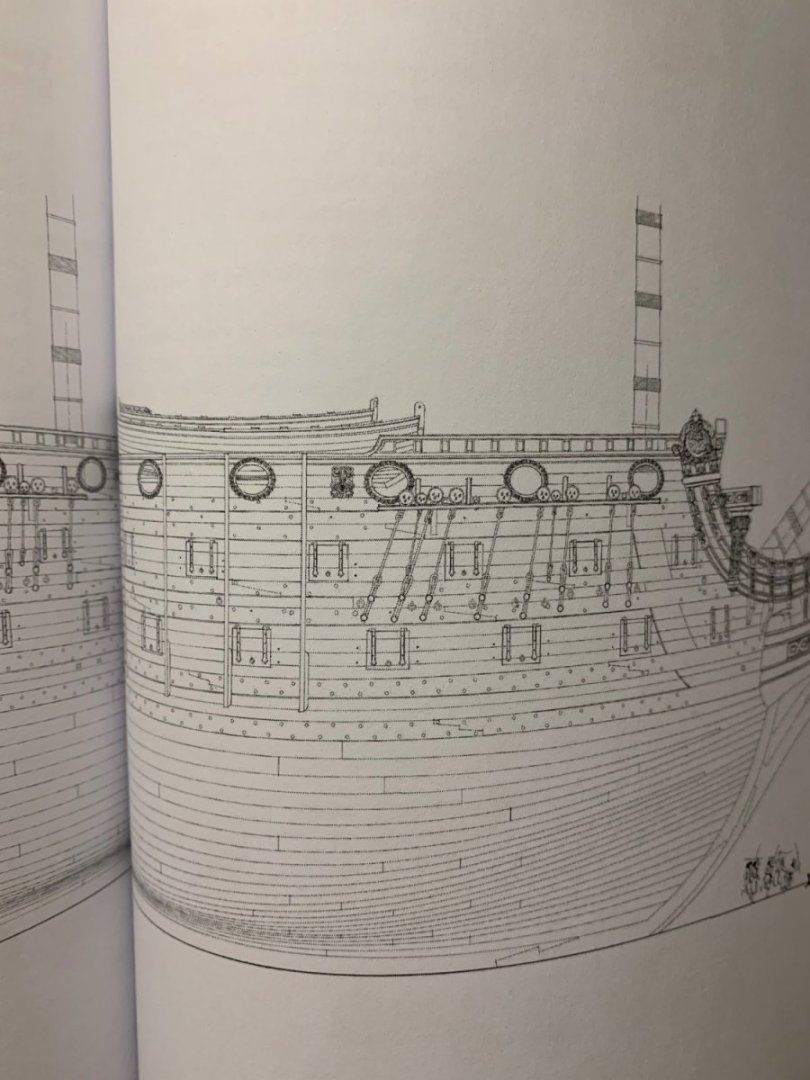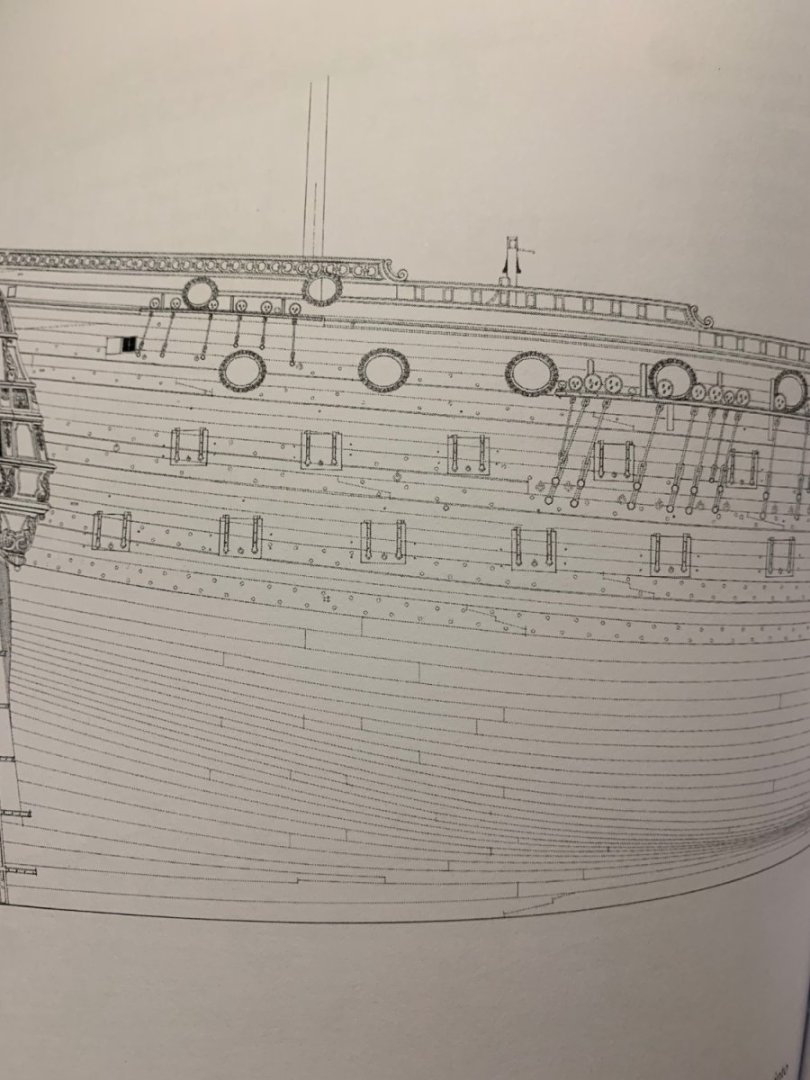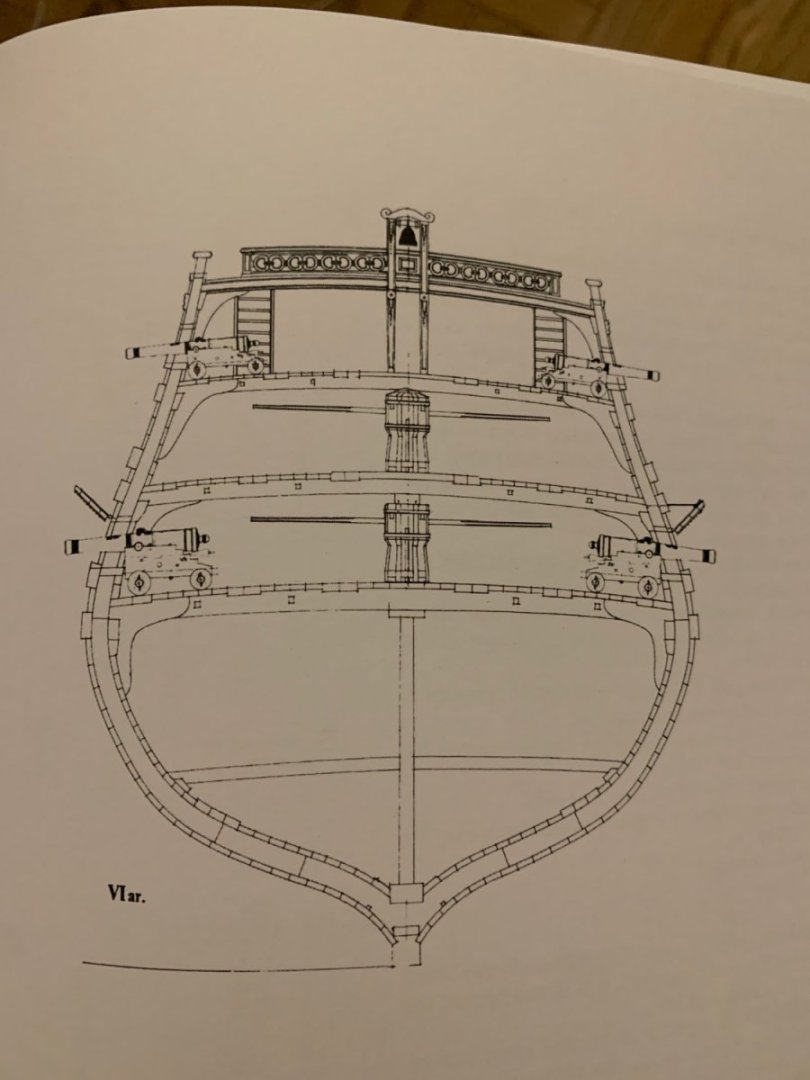-
Posts
2,946 -
Joined
-
Last visited
Content Type
Profiles
Forums
Gallery
Events
Everything posted by Hubac's Historian
-
Well, when simulating a deck with underlying framing, you have to first determine the likely spacing of the beams. The hatchways are always a useful starting point for figuring this out. Once you have a reasonable layout - and I don’t think this necessarily has to exactly match that of the Endeavor replica, it just has to be plausible and regular - you can then figure out, at scale, where planks land on beams within the 25-30’ range. This is one of those things where, since you’re not making a rigorous, fully framed and exact copy of the original ship, there is some latitude, IMO, in executing the details. The goal is an improvement over stock, and that the execution not be jarringly wrong. Of course, the Endeavor is an example of a type of ship called a “Whitby Cat.” If you did want to produce a fully authentic deck layout, I don’t imagine you would have too much difficulty finding original construction drafts that would show the deck framing. It’s really up to you, as to how far you want to take it.
-
I hadn’t realized how far behind I’d fallen on your build, Michael. She truly is the “Golden Devil,” now! Really beautiful paint work and filling-in of the missing ornamentals.
- 104 replies
-
- Sovereign of the Seas
- Airfix
-
(and 1 more)
Tagged with:
-
As always, B.E., a very impressive build!
- 637 replies
-
- Indefatigable
- Vanguard Models
-
(and 1 more)
Tagged with:
-
Many congratulations, Bill, on completing this magnificent model. I have always thought this model looks best on its waterline, and the diorama you have created shows her to best advantage. I look forward to watching your Endeavor take shape!
- 1,503 replies
-
- Le Soleil Royal
- Heller
-
(and 1 more)
Tagged with:
-
This remains one of my favorite models, Siggi. The paint work is beautiful, but aged to perfection so that it is not perfectly pristine. The woodwork is beautifully executed and always in-scale, and the symmetry from port to starboard is beyond reproach. I also like that this tine period for English warships is the beginning of the end for elegantly rising sheer-lines; in the following decades everything becomes significantly flatter.
-
Ian, your insights into this kit are just incredible. It would never have occurred to me to think this far ahead.
-
Great video, Bill. I never realized there was fore and aft duct work to help ventilate the hold.
- 1,503 replies
-
- Le Soleil Royal
- Heller
-
(and 1 more)
Tagged with:
-
Guns look awesome, Kevin! Those inks are magic. I like how you printed the cap squares to be integral with tue trunnions.
-
Hi Mark - it is great to see you working again! About a decade ago, I had a pretty vexing bout of sciatica. My deteriorating hip and the resulting over-compensations are what were driving it, but I found quite a lot of relief through specific yoga stretches that helped open my lower back. Also, a lot of hamstring stretching. After the hip replacement, the sciatica went away, but I still do the stretching routine every day. I wish you relief, as I remember how debilitating that particular problem can be.
-
For carving the split-tail tritons out of wood, my inclination would be to carve from the thighs, on up, first, while leaving the twisted lower legs oversized and for last. Before carving them, I’d make a backing piece that the carving fits into, and temporarily fix it in-place with a glue that could be dissolved in alcohol later. This support block should have a long enough handle, or extension, so that it can be clamped in a vice for working the fine details. You have done really beautiful work! I’m enjoying the build very much.
-
Thanks for the reference, Eric! This is all shaping up very nicely.
- 95 replies
-
- Ship of the line
- Heller
-
(and 2 more)
Tagged with:
-
Eric, can you please remind me where you purchased these rivets from? They look like the ideal fastener for my chain preventer plate links.
- 95 replies
-
- Ship of the line
- Heller
-
(and 2 more)
Tagged with:
-
Ian, we are here for that when you do start your SR. You know you want to 🙃
- 1,503 replies
-
- Le Soleil Royal
- Heller
-
(and 1 more)
Tagged with:
-
I agree with Henry, at a maximum, and would veer toward one plank width or slightly less. The Heller model is a very tall superstructure.
- 1,503 replies
-
- Le Soleil Royal
- Heller
-
(and 1 more)
Tagged with:
-
You are very right about that Bill. It is a task that I know how to go about with some efficiency and guaranteed clean results, and that is comforting. ‘Especially so because I have spent quite a lot of the past five months in a state of observation and contemplation over how, exactly, to tackle the more difficult and unfamiliar aspects of the build. Apart from the deadeye strops, I really wasn’t happy with any of my other link-making for the chains. Finally, I remembered that Andre Kudin has produced an extremely detailed YouTube log that accompanies his MSW build of Le Fleuron. Granted, he is working in 1:48, and with a substantially heavier gauge of wire, but his chains have no kinks or tell-tale deficiencies of technique, so I searched through his videos to see exactly what he does. I’ll do a more detailed post on this later, but Andre has absorbed the lessons of the great contemporary Russian masters, and he has quite a lot of original ingenuity that he demonstrates so clearly in his videos. Suffice it to say, for now, that Andre gave me confidence to pick up with that project again and know that I can achieve similarly excellent results. His videos really are superb and you can turn-on English captions to understand what he’s saying and appreciate his humor. Although I wish I were more active with the actual building of the model, I console myself with the understanding that this mental incubation period is useful and necessary to become a better modeler that isn’t intimidated by metal work or rigging. We all get where we’re going eventually.
- 2,444 replies
-
- heller
- soleil royal
-
(and 9 more)
Tagged with:
-
Gary, congratulations on finding a home filled with eager and inquisitive eyes for the Underwood. Work of your standard and attention to detail is precisely the sort that might inspire someone to give the hobby a try. I love the elegant lines of these workman boats that you build. The Pelican is shaping up beautifully.
-
Truly lovely Eberhard, a thing come to life. This is exquisite work in such a small scale!
-
Well, Micheal D. (72Nova) did an excellent job of setting his full-hull SR into a seaway. He showed me a few pictures, at one point, and as I recall, the case base was made deeper to accept the depth of the hull below the waterline. I can’t remember what his approach was to making the water, but it really looked great.
- 1,503 replies
-
- Le Soleil Royal
- Heller
-
(and 1 more)
Tagged with:
-
I thought it might interest you to take a look at the brilliant Andre Kudin’s video series for his Fleuron, 1729. In this installment he is making the lid lanyard grommets. His process for doing this on a wooden model isn’t as important as what the finished grommet looks like. Granted, there is a good 50+ years between Fleuron and SR, but there is some insight to be gleaned. You can turn on English subtitles in his videos to understand what he is saying. Andre is an extremely resourceful modeler, and his Fleuron is a true gem of the craft:
- 95 replies
-
- Ship of the line
- Heller
-
(and 2 more)
Tagged with:
-
Skids look awesome, Eric! That’s a whole lotta’ drilling, but it will be worth the effort in the end.
- 95 replies
-
- Ship of the line
- Heller
-
(and 2 more)
Tagged with:
-
Boudriot and Lemineur are the period authorities on the matter, so I would trust that they have read the fine print on these small details.
- 95 replies
-
- Ship of the line
- Heller
-
(and 2 more)
Tagged with:
-
Hi Eric, The St. Philippe monograph shows an equidistant transition that crosses the wale and pierces it around mid-ships: The L’Ambiteaux monograph essentially shows the same thing. A cross-section, where the lanyard passes through the wale: In the broadside, the lanyards themselves are omitted, but the holes are present: Sorry for the poor photo quality.
- 95 replies
-
- Ship of the line
- Heller
-
(and 2 more)
Tagged with:
About us
Modelshipworld - Advancing Ship Modeling through Research
SSL Secured
Your security is important for us so this Website is SSL-Secured
NRG Mailing Address
Nautical Research Guild
237 South Lincoln Street
Westmont IL, 60559-1917
Model Ship World ® and the MSW logo are Registered Trademarks, and belong to the Nautical Research Guild (United States Patent and Trademark Office: No. 6,929,264 & No. 6,929,274, registered Dec. 20, 2022)
Helpful Links
About the NRG
If you enjoy building ship models that are historically accurate as well as beautiful, then The Nautical Research Guild (NRG) is just right for you.
The Guild is a non-profit educational organization whose mission is to “Advance Ship Modeling Through Research”. We provide support to our members in their efforts to raise the quality of their model ships.
The Nautical Research Guild has published our world-renowned quarterly magazine, The Nautical Research Journal, since 1955. The pages of the Journal are full of articles by accomplished ship modelers who show you how they create those exquisite details on their models, and by maritime historians who show you the correct details to build. The Journal is available in both print and digital editions. Go to the NRG web site (www.thenrg.org) to download a complimentary digital copy of the Journal. The NRG also publishes plan sets, books and compilations of back issues of the Journal and the former Ships in Scale and Model Ship Builder magazines.





